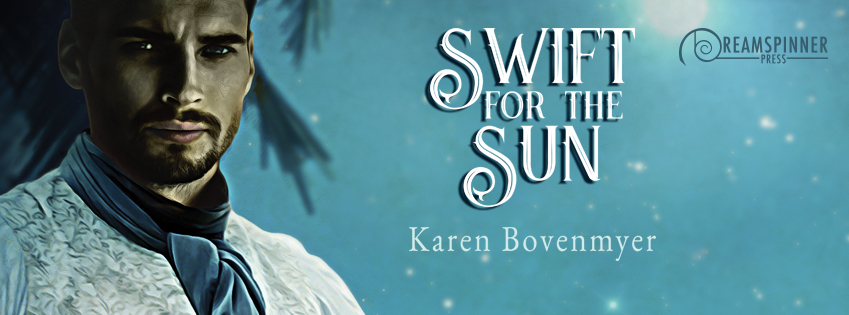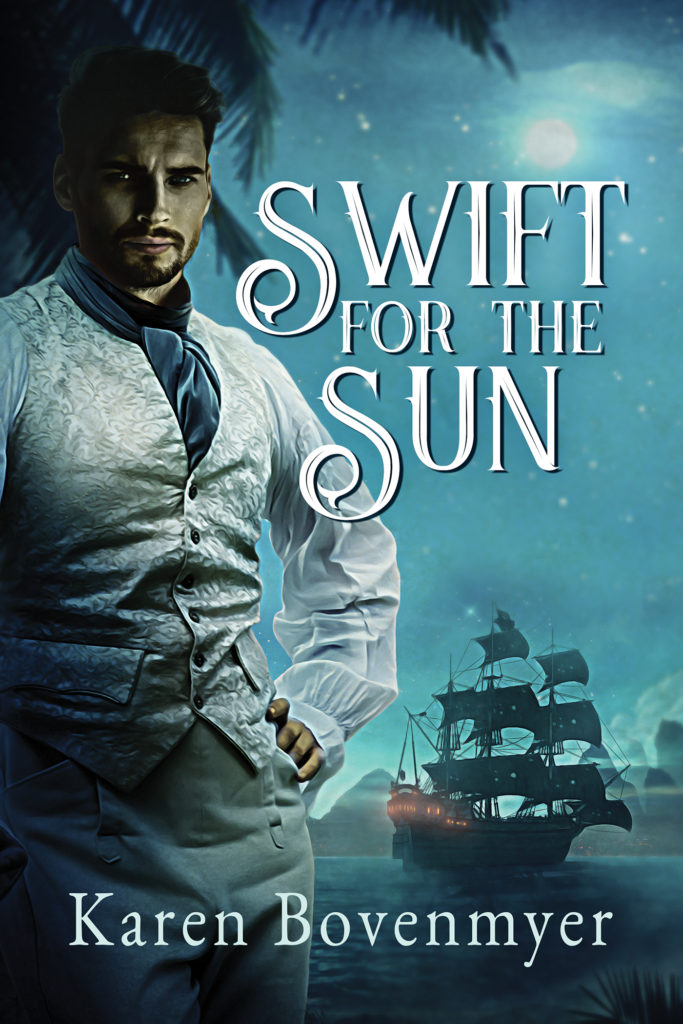Love Bytes says hello and welcome to author Karen Bovenmyer joining us today to talk about new release “Swift for the Sun”.
Inspired-Response Writing: Entering the “great conversation” with other authors
What is Inspired-Response Writing?
“But that’s plagiarism!” one of my students exclaimed while discussing a story published in Asimov’s March/April 2017 issue. “You can’t use another author’s ideas.” The story in question was Sarah Pinsker’s “The Ones Who Know Where They Are Going,” a retelling of Ursula K. Le Guin’s 1973 “The Ones Who Walk Away from Omelas” from the disadvantaged child’s point of view. If you haven’t read Le Guin’s original, I recommend looking it up, it’s a very powerful short story that was taught in the science fiction literature classes of my 1990s college experience. While Pinsker doesn’t mention Le Guin’s masterpiece (it is often conventional to say “from” or “after” so-and-so when writing a response piece that closely mimics the style of another) she didn’t need to. Le Guin’s original is so unique, thougth Pinsker’s style is different, I recognized and appreciated what Pinsker was trying to do and enjoyed the story immensely. As, no doubt, did Asimov’s editor, Sheila Williams, knowing that much of her readership would also “get” what Pinsker was doing—discoursing with Le Guin.
My creative writing teachers described inspired-response writing like this as the “great conversation” authors have with one another. Science fiction in particular is a genre of writing about new ideas, and it has always been common for scifi authors to explore concepts someone else has touched on with new approaches. I don’t think this is unique to scifi, and any student of literature can talk about a work’s “inspirations” by other works. It’s been said that every story has already been written—but I tell my students that their specific, personal, and relevant stories haven’t yet been written and can only be written by them. I believe with each new generation there are a range of questions humanity is interested in answering that only stories can explore in meaningful depth, simulating the human experience of the here and now, and using imagination to project human reaction in the future as well as the past with what we now understand about ourselves. The purpose, of course, is not only to sell great fiction, but inspire others to consider human questions in new ways and seek greater understanding of themselves and others.
Isn’t that Fan-Fiction?
It’s worth pointing out that inspired-response writing is different from fan-fiction. It does not necessarily “continue the dream” in the way that fan fiction often does (which I think is a way of coping with the grief of separation when a reader has very much enjoyed a story). Like fan-fiction, inspired-response may reuse the settings and even a named character (for examples, see the many responses created to Shakespeare reusing characters in different time periods). However, the point of inspired-response writing is to answer the question a work posed in a different way.
Have you ever read something that left you wondering if the story could have been told differently and been just as good? Have you wondered what happened to characters who had no or very few lines? Theodora Goss’s World Fantasy Award-winning “Singing of Mount Abora” explores the origin of a minor character in Coleridge’s Kulba Khan and creates a rich and beautiful fantasy story from the barest line of poetry. A line from Lovecraft’s short story The Dunwich Horror inspired my pantoum poem “Pseudopod” in Abyss and Apex (one of my first sales).
How does Inspired-Response Writing work?
Readers often ask authors where they get their ideas, a question many authors have problems answering. A single line of dialog. A solitary red door in a row of white buildings. The half-remembered taste of a meat pastry. Without explanation, at the most inconvenient of times, a story can ambush me when I’m least expecting it. Other times, I sit down to write and grind at the keyboard for hours and resurface, blinking in the daylight, with nothing worth salvaging.
Inspired-response writing can be a reliable way to create new stories when you want them. Schedule time to read an author that never fails to amaze and inspire you (for me, that’s Kelly Link). Immediately after reading the story, write for an hour or two (I created my flash fiction “What the Dollhouse Said” recently published on Pseudopod Podcast after reading Link’s “Catskin” in McSweeny’s). Re-read what you’ve come up with and think about how you’re in conversation with the author you read.
Dos and Don’ts
- Do make something new and unique—an interesting question answered a different way, an idea or character explored that wasn’t in the original.
- Don’t use words or phrases without attribution.
- When in doubt, do state “after AuthorName’s StoryTitle” in your manuscript. Sometimes editors will let you know whether or not the attribution is needed. In Pinsker’s case, it would have been too obvious—part of the fun of reading “The Ones Who Know Where They Are Going” was realizing what it was in response to.
- Don’t let your fears stop you from creating.
- However, do share your Inspired-Response with other experienced writers and explain what you were trying to do before sending it out to ensure your new piece is unique enough.
Got it? Great! Now go out there and read wonderful, inspiring work, give yourself really hard questions to answer, and jump into the great conversation with some Inspired-Response writing.
Title: Swift for the Sun
Author: Karen Bovenmyer
Publisher: Dreamspinner Press
Release Date: Mar 27, 2017
Pages: 230
Cover artist: Anna Sikorska
Blurb:
Benjamin Lector imagines himself a smuggler, a gun runner, and an all-around scoundrel. A preacher’s son turned criminal, first and foremost, he is a survivor.
When Benjamin is shipwrecked on Dread Island, fortune sends an unlikely savior—a blond savage who is everything Benjamin didn’t know he needed. Falling in love with Sun is easy. But pirates have come looking for the remains of Benjamin’s cargo, and they find their former slave, Sun, instead.
Held captive by the pirates, Benjamin learns the depths of Sun’s past and the horrors he endured and was forced to perpetrate. Together, they must not only escape, but prevent a shipment of weapons from making its way to rebellious colonists. Benjamin is determined to save the man he loves and ensure that a peaceful future together is never threatened again. To succeed might require the unthinkable—an altruistic sacrifice.
Buy Links:
 Karen Bovenmyer earned an MFA in Creative Writing: Popular Fiction from the University of Southern Maine. She teaches and mentors students at Iowa State University and serves as the Nonfiction Assistant Editor of Escape Artists’ Mothership Zeta Magazine. She is the 2016 recipient of the Horror Writers Association Mary Wollstonecraft Shelley Scholarship. Her poems, short stories and novellas appear in more than 40 publications and her first novel, SWIFT FOR THE SUN, an LGBT romantic adventure in 1820s Caribbean, will be available from Dreamspinner Press on March 27, 2017. http://karenbovenmyer.com/
Karen Bovenmyer earned an MFA in Creative Writing: Popular Fiction from the University of Southern Maine. She teaches and mentors students at Iowa State University and serves as the Nonfiction Assistant Editor of Escape Artists’ Mothership Zeta Magazine. She is the 2016 recipient of the Horror Writers Association Mary Wollstonecraft Shelley Scholarship. Her poems, short stories and novellas appear in more than 40 publications and her first novel, SWIFT FOR THE SUN, an LGBT romantic adventure in 1820s Caribbean, will be available from Dreamspinner Press on March 27, 2017. http://karenbovenmyer.com/
Social Media Links:
https://www.linkedin.com/in/karenbovenmyer
https://www.facebook.com/karen.bovenmyer
https://twitter.com/karenbovenmyer




